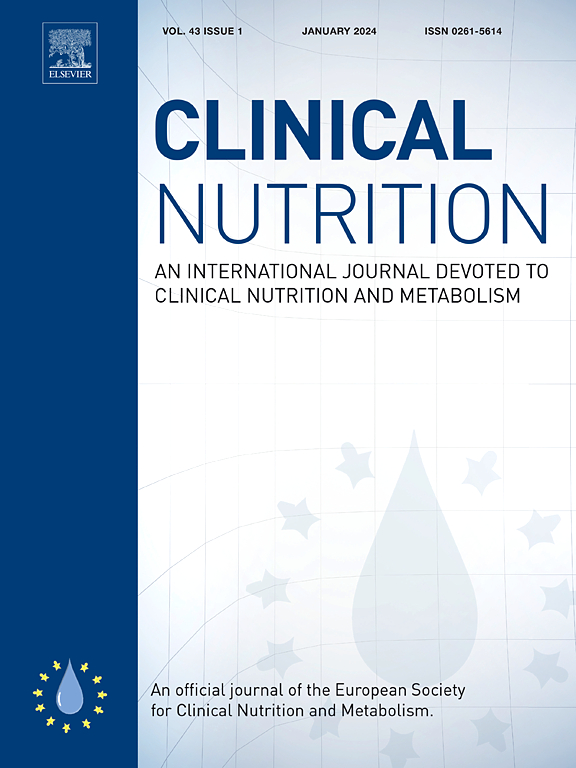Three-year lifestyle changes, genetic risk, and risk of frailty among older adults: A national community-based cohort study
IF 6.6
2区 医学
Q1 NUTRITION & DIETETICS
引用次数: 0
Abstract
Background
The association between change in lifestyle in late-life and frailty mediated by genetic risk is yet to be elucidated. This study aimed to investigate the associations of change in lifestyle in late-life and genetic risk with frailty among older adults.
Methods
6945 participants aged 65 or older were included from the Chinese Longitudinal Healthy Longevity Survey. Three-year lifestyle changes were assessed by comparing the first survey (2002, 2005, 2008, 2011) with the second survey (2005, 2008, 2011, 2014), evaluating changes in overall lifestyle scores, lifestyle combinations, and four factors (smoking, alcohol use, physical activity, and diet). A weighted polygenic risk score was constructed using 25 frailty-associated Single Nucleotide Polymorphism in a subsample of 4346 participants. Frailty was defined as a frailty index ≥0.25. Cox proportional hazards regression models, with age as the time scale and stratified by 5-year age groups, were used to estimate the interaction between genetic and lifestyle factors on frailty risk.
Results
During a median follow-up time of 5.7 years [interquartile range (IQR): 3.1–8.9), 2525 participants developed frailty. Compared to consistently unhealthy lifestyles, the hazard ratios (HRs) for frailty were 0.64 [95 % confidence interval (CI): 0.54–0.75] for healthy-to-healthy, 0.80 (95 % CI: 0.68–0.93) for moderate-to-moderate, and 0.83 (95 % CI: 0.70–0.99) for moderate-to-healthy changes. Participants with a high genetic risk group suffered from 87 % (95%CI: 1.68–2.08) higher risk of frailty. Notably, the highest frailty risk was observed in individuals with high genetic risk who changed from a healthy to an unhealthy lifestyle (HR: 2.86, 95%CI: 1.89–4.34).
Conclusion
Improving or maintaining a healthy lifestyle over three years, even in late life, was associated with a lower risk of frailty. This underscores the importance of a healthy lifestyle in preventing frailty, particularly for individuals with a high genetic risk.
三年生活方式改变、遗传风险和老年人衰弱风险:一项全国性社区队列研究
背景:由遗传风险介导的晚年生活方式的改变和身体虚弱之间的关系还有待阐明。本研究旨在探讨老年人晚年生活方式的改变和遗传风险与身体虚弱的关系。方法从中国健康长寿纵向调查中纳入6945名65岁及以上的参与者。通过比较第一次调查(2002年、2005年、2008年、2011年)和第二次调查(2005年、2008年、2011年、2014年)来评估三年生活方式的变化,评估总体生活方式得分、生活方式组合和四个因素(吸烟、饮酒、体育活动和饮食)的变化。在4346名参与者的子样本中,使用25个脆弱相关的单核苷酸多态性构建加权多基因风险评分。虚弱定义为虚弱指数≥0.25。采用Cox比例风险回归模型,以年龄为时间尺度,按5岁年龄组分层,估计遗传和生活方式因素对衰弱风险的相互作用。结果在5.7年的中位随访期间[四分位间距(IQR): 3.1-8.9), 2525名参与者出现虚弱。与一贯不健康的生活方式相比,健康到健康的衰弱风险比(hr)为0.64[95%可信区间(CI): 0.54-0.75],中度到中度的风险比为0.80 (95% CI: 0.68-0.93),中度到健康的风险比为0.83 (95% CI: 0.70-0.99)。高遗传风险组的参与者身体虚弱的风险高出87% (95%CI: 1.68-2.08)。值得注意的是,在从健康生活方式转变为不健康生活方式的高遗传风险个体中,脆弱风险最高(HR: 2.86, 95%CI: 1.89-4.34)。结论改善或保持健康的生活方式超过三年,甚至在晚年,与较低的虚弱风险相关。这强调了健康的生活方式在预防虚弱方面的重要性,特别是对具有高遗传风险的个人而言。
本文章由计算机程序翻译,如有差异,请以英文原文为准。
求助全文
约1分钟内获得全文
求助全文
来源期刊

Clinical nutrition
医学-营养学
CiteScore
14.10
自引率
6.30%
发文量
356
审稿时长
28 days
期刊介绍:
Clinical Nutrition, the official journal of ESPEN, The European Society for Clinical Nutrition and Metabolism, is an international journal providing essential scientific information on nutritional and metabolic care and the relationship between nutrition and disease both in the setting of basic science and clinical practice. Published bi-monthly, each issue combines original articles and reviews providing an invaluable reference for any specialist concerned with these fields.
 求助内容:
求助内容: 应助结果提醒方式:
应助结果提醒方式:


